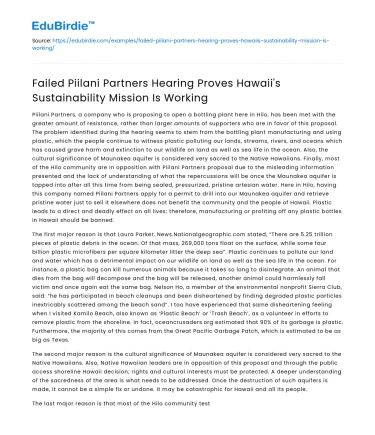Piilani Partners, a company who is proposing to open a bottling plant here in Hilo, has been met with the greater amount of resistance, rather than larger amounts of supporters who are in favor of this proposal. The problem identified during the hearing seems to stem from the bottling plant manufacturing and using plastic, which the people continue to witness plastic polluting our lands, streams, rivers, and oceans which has caused grave harm and extinction to our wildlife on land as well as sea life in the ocean. Also, the cultural significance of Maunakea aquifer is considered very sacred to the Native Hawaiians. Finally, most of the Hilo community are in opposition with Piilani Partners proposal due to the misleading information presented and the lack of understanding of what the repercussions will be once the Maunakea aquifer is tapped into after all this time from being sealed, pressurized, pristine artesian water. Here in Hilo, having this company named Piilani Partners apply for a permit to drill into our Maunakea aquifer and retrieve pristine water just to sell it elsewhere does not benefit the community and the people of Hawaii. Plastic leads to a direct and deadly effect on all lives; therefore, manufacturing or profiting off any plastic bottles in Hawaii should be banned.
The first major reason is that Laura Parker, News.Nationalgeographic.com stated, “There are 5.25 trillion pieces of plastic debris in the ocean. Of that mass, 269,000 tons float on the surface, while some four billion plastic microfibers per square kilometer litter the deep sea”. Plastic continues to pollute our land and water which has a detrimental impact on our wildlife on land as well as the sea life in the ocean. For instance, a plastic bag can kill numerous animals because it takes so long to disintegrate. An animal that dies from the bag will decompose and the bag will be released, another animal could harmlessly fall victim and once again eat the same bag. Nelson Ho, a member of the environmental nonprofit Sierra Club, said: “he has participated in beach cleanups and been disheartened by finding degraded plastic particles inextricably scattered among the beach sand”. I too have experienced that same disheartening feeling when I visited Kamilo Beach, also known as ‘Plastic Beach’ or ‘Trash Beach’, as a volunteer in efforts to remove plastic from the shoreline. In fact, oceancrusaders.org estimated that 90% of its garbage is plastic. Furthermore, the majority of this comes from the Great Pacific Garbage Patch, which is estimated to be as big as Texas.
Save your time!
We can take care of your essay
- Proper editing and formatting
- Free revision, title page, and bibliography
- Flexible prices and money-back guarantee
The second major reason is the cultural significance of Maunakea aquifer is considered very sacred to the Native Hawaiians. Also, Native Hawaiian leaders are in opposition of this proposal and through the public access shoreline Hawaii decision; rights and cultural interests must be protected. A deeper understanding of the sacredness of the area is what needs to be addressed. Once the destruction of such aquifers is made, it cannot be a simple fix or undone. It may be catastrophic for Hawaii and all its people.
The last major reason is that most of the Hilo community testimony was universally negative and rejected Piilani Partners proposal due to the misleading information presented and the lack of understanding of what the repercussions will be once the Maunakea aquifer is tapped into after all this time from being sealed and pressurized. Here are a few testimonies shared at the Windward Planning Commission: Shirley Hargrove said, “Waste that’s indestructible; it won’t biodegrade”; Nani Pai, said, “The measure of wealth in the old time was Waiwai”. In accordance with public trust doctrine in Hawaii, all water sources in Hawaii are a public trust and the State of Hawaii has a fiduciary responsibility to use the public trust resources not only for the general public but specifically for the betterment of the Native Hawaiians. After reviewing a recent news article published from HNN, I found out that Hawaii lawmakers are considering an outright ban on all sorts of single-use plastics common in the food and beverage industry, from plastic bottles to plastic utensils to plastic containers.
In conclusion, this proposal of opening a bottling plant in Hilo would not contribute to Hawaii’s mission for sustainability, but rather contribute to the waste stream that will cause the extinction of mankind. I believe we as a community must begin taking steps to become better stewards of this land and this ocean that surrounds us. Hawaii state has already banned plastic bags, polystyrene and soon to be plastic straws, so they should also ban plastic bottles.
Works Cited
- 'Ocean Trash: 5.25 Trillion Pieces And Counting, But Big Questions Remain'. News.Nationalgeographic.Com, 2019, https://news.nationalgeographic.com/news/2015/01/150109-oceans-plastic-sea-trash-science-marine-debris/. Accessed 8 Feb 2019.
- 'Plastic Statistics'. Ocean Crusaders, 2019, http://oceancrusaders.org/plastic-crusades/plastic-statistics/. Accessed 8 Feb 2019. Harvey, Fiona.
- 'Scientists Call For Better Plastics Design To Protect Marine Life'. The Guardian, 2019, https://www.theguardian.com/environment/2016/jul/14/scientists-call-for-better-plastics-design-to-protect-marine-life. Accessed 7 Feb 2019.






 Stuck on your essay?
Stuck on your essay?

